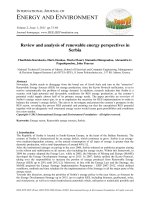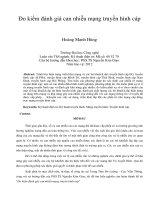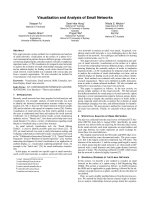E-Recruiting Categories and Analysis of Fortune 100 Career Web Sites
Bạn đang xem bản rút gọn của tài liệu. Xem và tải ngay bản đầy đủ của tài liệu tại đây (719.74 KB, 15 trang )
86 Lee
Copyright © 2005, Idea Group Inc. Copying or distributing in print or electronic forms without written
permission of Idea Group Inc. is prohibited.
Chapter IV
E-Recruiting:
Categories and Analysis of
Fortune 100
Career Web Sites
In Lee, Western Illinois University, USA
Abstract
Since the mid-1990s, a number of e-recruiting methods such as job
boards, corporate career Web sites, and e-recruiting consortia have been
introduced into the labor market. Recruiting through the corporate career
Web site has been touted as the most efficient and cost-effective recruiting
method among them. While most large and medium-sized organizations
have deployed corporate career Web sites, many of them have failed to
achieve the maximum benefits because they do not have the appropriate
e-recruiting practice in place. After identifying six categories of e-
recruiting sources, this study analyzes the corporate career Web sites of
the Fortune 100 companies. Thirty-three attributes that characterize the
E-Recruiting 87
Copyright © 2005, Idea Group Inc. Copying or distributing in print or electronic forms without written
permission of Idea Group Inc. is prohibited.
corporate career Web sites were identified, named, and analyzed around
four major categories: recruiting methods, job search tools, job application
tools, and information on organizational attributes.
Introduction
Currently, e-recruiting is one of the most successful e-commerce applications
as a method for quickly reaching a large pool of the potential job seekers. The
capability of advanced e-recruiting tools has enabled recruiters to quickly
identify and hire qualified candidates, and to build ongoing relationships with
prospective employees. According to Forrester Research (www.forrester.com),
the average cost of hiring an employee via the Internet is US$183, whereas the
average cost of hiring an employee via the traditional methods (i.e., newspapers
or magazines) is $1,383. Forrester Research predicted that corporate recruit-
ers would increase the e-recruiting budget by 52% by 2004, while cutting the
budget for traditional recruitment by 31%.
Major advantages cited for the successful adoption of e-recruiting methods
include cost savings, efficiency, and convenience for both recruiters and job
seekers (Tomlinson, 2002; Miller, 2001; Gale, 2001). In a 2001 poll of 400
recruiters by Recruiters Network (www.recruitersnetwork.com), 46% indi-
cated that e-recruiting was the most effective way to get the most hires and best
résumés, followed by referrals (35%) and newspaper classifieds (11%).
There has been a fundamental shift in the way companies use the e-recruiting
methods since their inception in the mid-1990s. While most companies utilize
at least one of the third-party job boards, more and more companies are
creating their own corporate career Web sites. According to iLogos’ research
(), 29% of Global 500 companies had corporate career
Web sites and 57% subscribed to the third-party job boards in 1998. In 2002,
the figure had changed to 91% and 9%, respectively.
The main purposes of this chapter are to classify the various e-recruiting
sources and to analyze the content of Fortune 100 companies’ career Web
sites. This chapter is organized as follows: The first section compares the
traditional recruiting and e-recruiting processes. Six major categories of the e-
recruiting sources are then discussed, followed by a content analysis of the
Fortune 100 companies’ career Web sites. The chapter concludes with future
e-recruiting trends.
88 Lee
Copyright © 2005, Idea Group Inc. Copying or distributing in print or electronic forms without written
permission of Idea Group Inc. is prohibited.
Background: Traditional Recruiting
vs. E-Recruiting Processes
The traditional recruiting process consists of the following iterative phases:
identification of hiring needs; submission of job requisition and approval; job
posting, submission of job applications; screening of résumé/application;
interviewing; pre-employment screening; and job offer and employment con-
tract. Both hiring managers and recruiters rely on hard-copy documents and
conventional delivery mechanisms to complete the recruiting process.
The traditional recruiting process is typically a step-by-step sequential process
whereby the subsequent phase starts the required tasks only after the previous
phase completes its tasks. Labor-intensive hiring tools like face-to-face
interviews, paper and pencil tests, and job previews are widely used in
traditional recruiting. The traditional process has been fraught with task delays
and miscommunications, which result in the long hiring process and high hiring
cost.
Computers had been used in the traditional recruiting process even before the
introduction of e-recruiting. However, computer applications were limited to
the automation of internal processes rather than the rationalization of the
process. Software packages could not communicate with each other, and the
quantity and quality of the job applications remained the same. Even with
automation, most recruiting processes were still batch processes. The advent
of e-recruiting moved the computer application of the recruiting process to a
higher level. The e-recruiting system is a Web-enabled, “anytime-anyplace,”
ubiquitous system for both job seekers and recruiters.
We define the e-recruiting as practices and activities carried on by the
organization that utilizes a variety of electronic means to fill open
positions effectively and efficiently. The e-recruiting process consists of the
following iterative steps: identification of hiring needs; submission of job
requisition; approval of the job requisition via a job database; job posting on
the Internet; online search of the job database by job seekers, online pre-
screening/online self-assessment; submission of applications by applicants
directly into an applicant database; online search of the applicant database for
candidate selection; online evaluation of résumé/application; interviewing by
recruiters/hiring managers; online pre-employment screening; and job offer and
employment contract.
E-Recruiting 89
Copyright © 2005, Idea Group Inc. Copying or distributing in print or electronic forms without written
permission of Idea Group Inc. is prohibited.
While traditional recruiting is characterized as a sequential batch process, e-
recruiting is characterized as a continuous and online process in which some of
the recruiting activities may be performed concurrently. The benefits of e-
recruiting are accomplished with the extensive use of a centralized job database
and an array of Web-enabled integrated applications. For example, when there
is a need for a new employee, hiring managers may prepare the job requisition
by entering the predefined job code into the job analysis database and
retrieving a detailed list of the job requirements. The submission of the retrieved
job requisition to division managers is electronically processed. Once the job
requisition is approved, the job requisition data are used for the job posting at
the career Web site. The job requisition data are also used to search résumés
based on specific criteria/keywords. The qualified candidates are further
narrowed down with an additional screening process that utilizes various online
Table 1. Summary of six categories of the e-recruiting sources: Recruiters’
perspectives
E-Recruiting Source Advantages Disadvantages Sample Participants
General-Purpose Job Board Brand recognition; E-
recruiting experience;
High traffic; Industry bes
t
tools; Large candidate
base; Large recruiter base
Relatively high job
posting cost;
Potentially low
quality applications;
Limited content
control; Stickiness of
the job board; Limited
candidate relationship
Monster.com;
HotJobs.com;
CareerBuilder.com
Niche Job Board Gathering of passive job
seekers; Focused search;
Community of
professionals
Low brand
recognition;
Possibility of identity
theft
Dice.com;
Erexchange.com;
Taon-line.com;
JournalismJobs.com;
MarketingJobs.com;
TexasJobs.com
E-Recruiting Application
Service Provider
Low application
development cost for
recruiters; Quick
application development
Integration issues
with existing systems
;
Possibility of closeout
due to competition;
Possibility of lock-in;
Low traffic
Recruitsoft; Brassring;
RecruitUSA;
PeopleClick;
TalentFusion; Lawson
Hybrid Recruiting Service
Providers
Expertise in advertising
industry; Portfolio of
recruiting media;
Price bundling with
conventional media
Strong image as a
conventional media;
Low traffic; Low
technology
New York Times, Wall
Street Journal;
Chronicle of Higher
Education
E-Recruiting Consortium Low service cost; Direct
and immediate link to
corporate career site
Potential conflicts
among members; Low
exposure; Low
technology
DirectEmployers.com;
NACElink
Corporate Career Web Site Candidate relationship
management; High
interest in jobs by job
applicants; Integration
with exiting systems
Needs for IT
specialists; High up-
front development
cost
94% of Fortune 100
companies; 81% of
Fortune 500 companies
90 Lee
Copyright © 2005, Idea Group Inc. Copying or distributing in print or electronic forms without written
permission of Idea Group Inc. is prohibited.
and off-line interview and test tools, and then the company conducts an online
pre-employment background check and makes a job offer to the best candi-
date.
Categories of E-Recruiting Sources
Corporate recruiters tend to be interested in such factors as whether certain
recruiting sources are more likely to yield a higher percentage of new hires,
whether certain sources are likely to generate minority applicants, and whether
the quality of job applicants is higher for certain recruiting sources (Barber,
1998). While numerous e-recruiting sources have been introduced to improve
the recruiting effectiveness since the mid-1990s, no formal classification system
for e-recruiting sources has been developed yet.
In order to give recruiters and job seekers a better understanding of the e-
recruiting methods, we surveyed a wide range of recruiting sources. Based on
this analysis, we identify six basic categories of the e-recruiting sources: (1)
general purpose job board, (2) niche job board, (3) e-recruiting application
service provider, (4) hybrid (online and off-line) recruiting service provider, (5)
e-recruiting consortium, and (6) corporate career Web site. Table 1 summa-
rizes the six categories of the e-recruiting sources.
The general-purpose job board provides a comprehensive online recruiting
solution to both employers and job seekers across different industries. Mon-
ster, HotJobs, and Careerbuilder are leaders in this category. Job seekers can
search for jobs by category, experience, education, location, or any combina-
tion of these job attributes. Most of the leading general-purpose job boards
employ an agent technology to increase utility for the job seekers and recruiters.
Personalized job agents match job seekers’ profiles with the latest job postings
and e-mail the list of the matched jobs to the job seekers.
The recruiters can search the job boards’ database based on the skill,
experience level, job preference, salary, education, and any combination of
keywords to find qualified candidates. To address job seekers’ and recruiters’
rising dissatisfaction with services and costs, the general-purpose job board
has evolved into an array of comprehensive career services, offering custom-
ized placement services, applicant assessment, and candidate relationship
management.
E-Recruiting 91
Copyright © 2005, Idea Group Inc. Copying or distributing in print or electronic forms without written
permission of Idea Group Inc. is prohibited.
The niche job board serves highly specialized job markets such as a particular
profession, industry, education, location, or any combination of these special-
ties. Sample profession-oriented niche job boards include JournalismJobs.com,
MarketingJobs.com, AllRetailJobs.com, and JobsInLogistics.com. Location-
oriented niche job boards include NJ.com, TexasJobs.com, and
ArizonaJobs.com. The advantage of the niche job board is a focused search
with which recruiters can reach a large pool of qualified candidates most
effectively. Most niche job boards operate specialized online communities or
newsgroups that draw professionals, such as engineers, programmers, and
journalists who share specific interests, skills, experience, and knowledge.
Both the general-purpose and niche job boards generate revenue by providing
recruiters with applicant tracking service, hiring tools, job posting, Web site
hosting, pre-screening tools, and advertisements. As the success of the job
boards depends on the critical mass of job applicants, the job boards typically
provide job seekers with free access to the services. Advanced services such
as résumé writing and interview guidance may be accessible to the job seekers
for a fee. The advantages of using the job boards include access to a large pool
of recruiters and job seekers, and availability of state-of-the-art e-recruiting
tools. Medium- and small-sized recruiters with low name recognition can
access a large pool of qualified job applicants at a reasonable cost.
Because of the relative ease of entry into the e-recruiting market, the general-
purpose and niche job boards overcrowded the e-recruiting industry in the late
1990s, and went through a series of mergers and acquisitions in the early 2000s.
For example, TMP, the parent company of Monster, acquired FlipDog in 2001
to gain competitive advantage in the general-purpose job board market.
Careerbuilder acquired CareerPath in 2000 and Headhunter.net in 2001.
Yahoo! acquired HotJobs, which became a wholly owned subsidiary of
Yahoo!
The e-recruiting application service provider (ASP) develops and markets
to recruiters and job boards a combination of specialized services in recruit-
ment software, recruitment process management, education and training, and
management expertise. Specialized recruitment software for the in-house
development of larger-scale e-recruiting Web sites is available for recruiters
who want to quickly develop career Web sites on their own servers. Some
service providers also support the hosting of the corporate career Web sites.
Widely known e-recruiting application service providers include Recruitsoft,
BrassRing, RecruitUSA, PeopleClick, TalentFusion, Lawson, and Develop-
ment Dimensions International Inc. These e-recruiting application service









